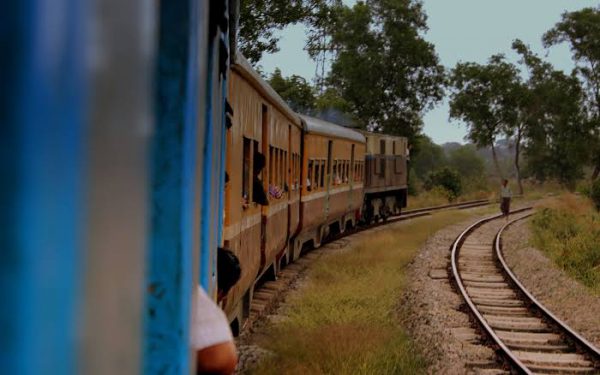YANGON, 22 November 2019: Dubbed the world’s cheapest train tour you pay USD15 cents to ride Yangon’s Circular Train that links the city suburbs and satellite towns in 45.9 km double track loop.
While it takes just short of three hours to ride the entire loop that is punctuated by 39 stations of varying importance, most visitors retrace the journey back to downtown Yangon after an hour of bumps and shunts at speeds that rarely exceed 20 kph.
The ride is listed as one of the top four “things to do” when visiting Yangon not for its scenic views but more for the lively carriage happenings that unfold as fresh actors jump on and off the ramshackle train at every station stop.

It clocked 1,942 reviews on TripAdvisor this week making it the third-highest after the iconic Shwedagon Pagoda with an astounding 13,492 reviews and Chaukhtatgyi Buddha with 2,604.
One reviewer commented: “Riding the Circle Line train provides a window into the daily routine of the Myanmar people away from the Yangon’s commercial centre” It certainly does that with an average of 150,000 passengers hopping on and off every day.
Today, you are just as likely to see foreign tourists boarding the ramshackle trains to mingle with the hordes of traders carrying fowl, fish and vegetables to the nearest market. But change is on the way as the city upgrades its rail systems.
In 2018, the remake began that will eventually drag the railway into the 21 century. British colonials built the original Yangon’s central station in 1877, while the former capital city’s circular train appears to have been established some years later and subsequently upgraded to double-track in 1954. Since then, very little changed until recent upgrades of the rolling stock, stations and track.
The estimated USD300 million improvement project partly funded by loans from the Japan Development Agency is due to be completed in 2022, but officials admit work is running behind schedule.
Eventually, an additional USD206 loan from the Japan International Cooperation Agency will bring in 11 diesel-electric trains each with six carriages to replace the ancient diesel rolling stock and carriages that number around 200.
While the line technically continues to circle the city from Yangon’s central station, the upgrades have forced some sections of the line to shut down, or services have been seriously curtailed. Earlier this year, seven stations closed for renovations and track improvements are still underway.
Once completed, the upgrade should cut the travel time on the entire loop from 170 minutes to 105 minutes and ultimately trains will run every 10 to 12 minutes at peak-hours and reach speeds of up to 60 kph.
In the meantime, it remains the ultimate slow travel experience for visitors, but one that will eventually be shunted aside by modern trains, smooth tracks and efficient looking stations over the next three years.
Rail officials claim “Yangon will be a megacity in 2022 and with a population of more than 8 million we will need an efficient, modern train system,” according to a recent report posted by Frontier Myanmar.
Cashing in on the popularity of this distinctive train experience travel companies offer half-day tours. The trips start and end at Yangon’s central railway station, a heritage building originally built in 1877 but flattened by Japanese bombers during World War II. An entirely new station was built on the site 1947 to 1954.
At speeds akin to a snail’s pace, the train rumbles along the circular track stopping at every one of the 39 stations. Some visitors disembark in Insein township after one hour where they can explore one of the city’s markets crowded with vendors selling fresh fruit, vegetables, and spices plus textiles and household appliances and utensils.
Usually, train rides are combined with a walking tour through Chinatown and Little India, two vibrant neighbourhoods of Yangon famed for their street markets, snacks, vendors and the diversity of places of worship and faith.
Early morning is the best time to enjoy the hustle and bustle of a train commute starting at Yangon Railway Station and ending at Danyingone Market, another popular spot to conclude the tour. It gives you plenty of time to explore and get back to downtown Yangon in time for a hearty lunch.
However, if you don’t fancy packed train carriages bursting at the seams with vendors who travel with live fowl prone to flight and fish splashing around in buckets then take a later train between 1000 and 1500.
You reach Danyingone market after 45 minutes on the train. At the station, you witness vendors nimbly dismantling and reassembling their stalls according to train arrivals. Goods for sale are piled between the tracks and transactions continue on the railway line until the next train warns shoppers it is about to rumble into the station. Over the years, vendors have fine-tuned their packing skills. Demonstrating considerable nerve they clear the track just seconds ahead of the approaching train. Then with the same alacrity, they reassemble their stalls between the track once the train passes by.
Usually, the early morning train tour concludes with a typical Burmese breakfast with a locally brewed tea or coffee before the travel firm provides a car for a fast trip back to the city centre.
Myanmar citizens pay Kyat100 just for the train ride while foreigners pay Kyat 300. (USD 20 cents)
A half-day tour featuring the train ride with snacks and return transfer by car costs USD36.50.
Main stations on the loop
Yangon Central
Dagon University
Danyingone
Hlawga
Insein
Mingaladon
Okhposu
Paywetseikkon
Thilawa
Togyaunggalay
Ywathagyi University of Computer Studies, Yangon






